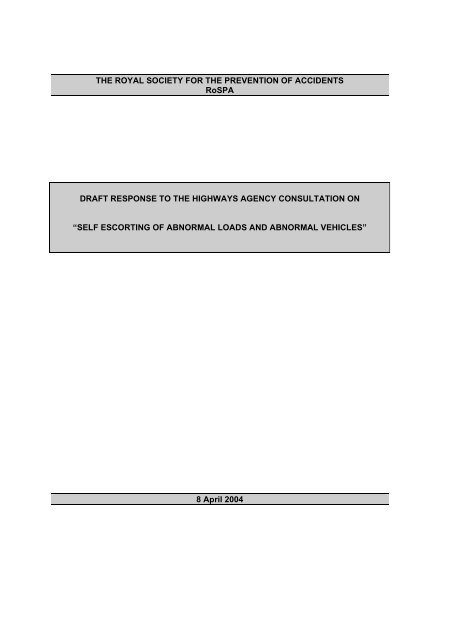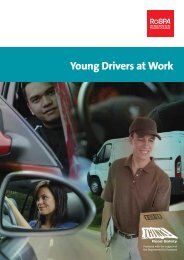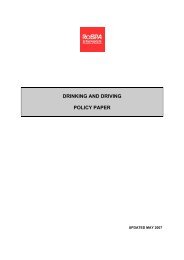Self Escorting Abnormal Loads and Abnormal Vehicles - RoSPA
Self Escorting Abnormal Loads and Abnormal Vehicles - RoSPA
Self Escorting Abnormal Loads and Abnormal Vehicles - RoSPA
You also want an ePaper? Increase the reach of your titles
YUMPU automatically turns print PDFs into web optimized ePapers that Google loves.
THE ROYAL SOCIETY FOR THE PREVENTION OF ACCIDENTS<br />
<strong>RoSPA</strong><br />
DRAFT RESPONSE TO THE HIGHWAYS AGENCY CONSULTATION ON<br />
“SELF ESCORTING OF ABNORMAL LOADS AND ABNORMAL VEHICLES”<br />
8 April 2004
The Royal Society for the Prevention of Accidents<br />
Response to the Highways Agency Consultation Paper<br />
“Proposed Code of Practice<br />
<strong>Self</strong>-<strong>Escorting</strong> of <strong>Abnormal</strong> <strong>Loads</strong> <strong>and</strong> <strong>Abnormal</strong> <strong>Vehicles</strong>”<br />
April 2004<br />
“Proposed Code of Practice: <strong>Self</strong>-<strong>Escorting</strong> of <strong>Abnormal</strong> <strong>Loads</strong> <strong>and</strong> <strong>Abnormal</strong><br />
<strong>Vehicles</strong>”<br />
This is the response of the Royal Society for the Prevention of Accidents (<strong>RoSPA</strong>) to<br />
the Highways Agency’s consultation paper. <strong>RoSPA</strong> welcomes the invitation to<br />
comment, <strong>and</strong> our response has been prepared following consultation with <strong>RoSPA</strong>’s<br />
National Road Safety Committee.<br />
GENERAL COMMENTS<br />
<strong>RoSPA</strong> welcomes the introduction of a code of practice for the self-escorting of<br />
abnormal loads <strong>and</strong> abnormal vehicles, although we feel that the proposed Code<br />
needs to be strengthened.<br />
We believe that it was right to retain the legal duties on hauliers to notify the Police<br />
<strong>and</strong> Highways Authorities before moving an abnormal load or vehicle.<br />
It is important that Police time that is no longer need for escorting wide loads <strong>and</strong><br />
abnormal vehicles is re-allocated to other roads policing duties to ensure that these<br />
changes do not lead to a lower police profile on our roads.<br />
<strong>RoSPA</strong> is surprised that the Code of Practice does not include information on how<br />
these new escort methods will be advertised to the motoring public. The escort<br />
vehicles <strong>and</strong> escort personnel are new concepts. The motoring public need to be<br />
made aware that these vehicles will be on the road, their legal status, the duties <strong>and</strong><br />
responsibilities of the personnel in charge of them <strong>and</strong> how they should behave<br />
around these wide loads <strong>and</strong> abnormal vehicles.<br />
As a separate matter, it would be useful to be able to identify accidents <strong>and</strong><br />
casualties involving abnormal vehicles <strong>and</strong> abnormal loads separately from those<br />
involving normal HGVs. This could inform the development of future guidance.<br />
SPECIFIC COMMENTS<br />
1 Introduction<br />
<strong>RoSPA</strong> Response<br />
The Code of Practice provides voluntary practical guidelines which can be adapted<br />
“in appropriate circumstances”. There should be a mechanism to ensure that the<br />
Code is regularly reviewed so that it can be amended in the light of experience <strong>and</strong><br />
practice. The greater flexibility allowed by the system should cause less<br />
inconvenience to the motoring public, but they need to be made aware that this new<br />
system will be coming into operation <strong>and</strong> its implications.<br />
The Code of Practice provides for st<strong>and</strong>ardised practice across Scotl<strong>and</strong>, Engl<strong>and</strong><br />
<strong>and</strong> Wales. However, the lack of legal status of the Accredited Level 2 escort person<br />
in Scotl<strong>and</strong> may cause problems when loads <strong>and</strong> vehicles are moving between<br />
Engl<strong>and</strong> <strong>and</strong> Wales. <strong>RoSPA</strong> has concerns that this issue does not appear to have<br />
been addressed in the Code of Practice.<br />
1
The Royal Society for the Prevention of Accidents<br />
Response to the Highways Agency Consultation Paper<br />
“Proposed Code of Practice<br />
<strong>Self</strong>-<strong>Escorting</strong> of <strong>Abnormal</strong> <strong>Loads</strong> <strong>and</strong> <strong>Abnormal</strong> <strong>Vehicles</strong>”<br />
April 2004<br />
2 <strong>Self</strong> Certification<br />
<strong>RoSPA</strong> Response<br />
The Code of Practice requires hauliers <strong>and</strong> sub contractors to ensure that their staff<br />
<strong>and</strong> vehicles comply with the code of practice <strong>and</strong> that staff can carry out their duties<br />
competently in accordance with road traffic <strong>and</strong> health <strong>and</strong> safety legislation. The<br />
Police have the power to ask to see a self-certificate or other evidence of compliance<br />
with the Code of Practice.<br />
<strong>RoSPA</strong> would recommend that these checks be made on a regular basis to ensure<br />
that the Code of Practice is being correctly followed. Failure to comply with road<br />
traffic <strong>and</strong> health <strong>and</strong> safety legislation could have major consequences.<br />
3 Vehicle Requirements<br />
<strong>RoSPA</strong> Response<br />
The Code of Practice states that the primary role of any escort vehicle is to alert<br />
other road users to the presence of an abnormal load or vehicle. To be successful in<br />
this role, the public must be aware of what the vehicle is <strong>and</strong> this can only be<br />
achieved by advertising their existence <strong>and</strong> appearance. This necessity is not<br />
covered in the Code of Practice.<br />
Where they are employed, an accredited Level 2 person has a role in controlling <strong>and</strong><br />
directing traffic. The motoring public need to be made aware of this role <strong>and</strong> the<br />
authority that such staff have to direct traffic. They are used to being directed by<br />
police officers or traffic wardens, but not Level 2 persons.<br />
The vehicle specifications on size <strong>and</strong> type, colour, exterior lights, markings <strong>and</strong><br />
identification, equipment <strong>and</strong> information to be carried in Escort <strong>Vehicles</strong> appear to<br />
be comprehensive. <strong>RoSPA</strong>’s one reservation is in the area of conspicuity where the<br />
uniform colours of white, yellow, orange or silver are recommended rather than a<br />
‘battenburg’ effect which research has shown to be best for conspicuity. However,<br />
the comprehensive chevron markings on the rear <strong>and</strong> to the side of the vehicle<br />
should have a similar effect.<br />
2
The Royal Society for the Prevention of Accidents<br />
Response to the Highways Agency Consultation Paper<br />
“Proposed Code of Practice<br />
<strong>Self</strong>-<strong>Escorting</strong> of <strong>Abnormal</strong> <strong>Loads</strong> <strong>and</strong> <strong>Abnormal</strong> <strong>Vehicles</strong>”<br />
April 2004<br />
4 Escort Person Specification<br />
<strong>RoSPA</strong> Response<br />
The Code of Practice defines two levels of ‘escort person’ :<br />
• level 1 who have no powers to stop or direct traffic<br />
• level 2 who will have an accreditation from a Police Constable to undertake the<br />
traffic direction of other road users.<br />
Comprehensive Job Descriptions for both posts are provided but <strong>RoSPA</strong> is<br />
concerned that the route to achieve accreditation has not yet been fully defined.<br />
Also, since this is a voluntary code of practice there are no enforcement measures in<br />
place to ensure that recruits meet these criteria.<br />
The Code states that it is the responsibility of hauliers or sub-contractors to satisfy<br />
themselves that their own escort personnel are sufficiently competent to carry out<br />
their duties. No doubt, in the event of an incident, the Police <strong>and</strong>/or HSE would<br />
investigate whether escort personnel were competent. However, The Code should<br />
include some mechanism for external checks without the need to wait for an incident<br />
to occur.<br />
5 Operation<br />
<strong>RoSPA</strong> Response<br />
<strong>RoSPA</strong> welcomes the requirement that the police abnormal load officer <strong>and</strong> the<br />
haulier agree the numbers of escort vehicles <strong>and</strong> personnel on a case-by-case basis.<br />
Escort persons are required to risk assess traffic <strong>and</strong> weather conditions, but this is<br />
not included in the Job Descriptions included in the previous sections. <strong>RoSPA</strong> would<br />
prefer to see this included in the job responsibilities to emphasise the importance of<br />
this item.<br />
In the case of breakdown, escort personnel are responsible for coning off the<br />
abnormal loads or vehicle. Therefore, it would be appropriate to include a clause in<br />
the job description that staff members are responsible for ensuring their own <strong>and</strong><br />
others’ safety.<br />
There is little specific advice for escorts or the drivers of abnormal loads <strong>and</strong> vehicles<br />
on how to perform in different types of road <strong>and</strong> traffic conditions. This means the<br />
advice is somewhat vague <strong>and</strong> open to interpretation.<br />
<strong>Escorting</strong> Criteria<br />
The Code provides escorting criteria, which are for guidance only, <strong>and</strong> can be varied<br />
by individual police forces. <strong>RoSPA</strong> would prefer to see basic st<strong>and</strong>ards for both<br />
motorways <strong>and</strong> all other roads above which an escort must be provided. Many<br />
abnormal loads need to be transported across police area boundaries <strong>and</strong><br />
differences between police forces could lead to confusion.<br />
3
The Royal Society for the Prevention of Accidents<br />
Response to the Highways Agency Consultation Paper<br />
“Proposed Code of Practice<br />
<strong>Self</strong>-<strong>Escorting</strong> of <strong>Abnormal</strong> <strong>Loads</strong> <strong>and</strong> <strong>Abnormal</strong> <strong>Vehicles</strong>”<br />
April 2004<br />
The criteria does not include speed. As some abnormal loads <strong>and</strong> vehicles move at<br />
slow speeds, the inclusion of a speed criteria should be considered. For example, a<br />
large vehicle moving at no more than 30 mph on a 70 mph dual carriageway<br />
represents a hazard even if it is not wide enough to protrude into the outside lane.<br />
<strong>RoSPA</strong> welcomes the inclusion of clauses highlighting the need for a police escort on<br />
certain routes or in certain situations, <strong>and</strong> that special order loads may require a<br />
combination of police <strong>and</strong> self-escort vehicles.<br />
The Society thanks the Highways Agency for the opportunity to comment on these<br />
proposals. We have no objections to our response being reproduced or attributed.<br />
Road Safety Department<br />
<strong>RoSPA</strong><br />
Edgbaston Park<br />
353 Bristol Road<br />
Birmingham B5 7ST<br />
0121 248 2000<br />
www.rospa.com<br />
4
















